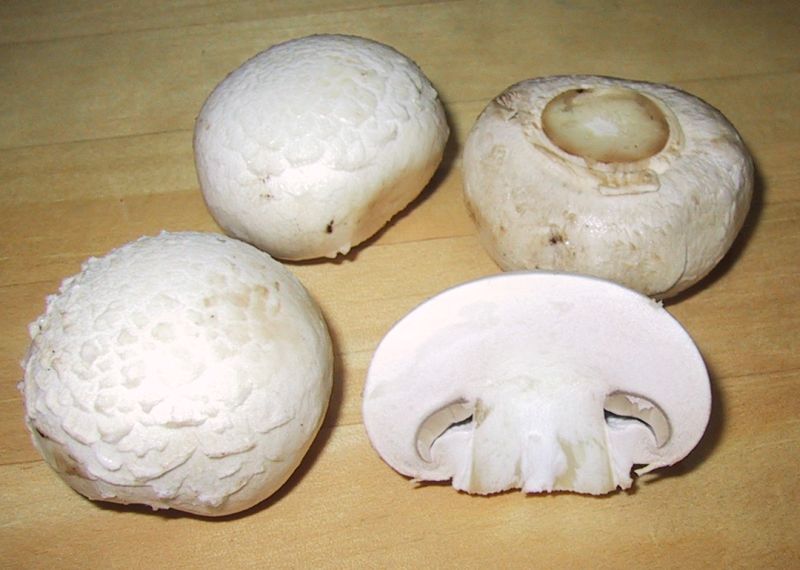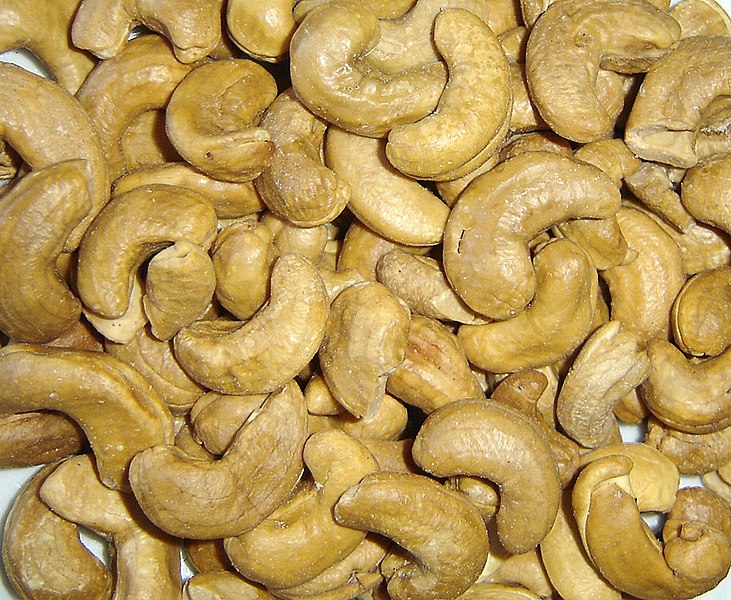Mushroom vs. Cashews
Nutrition comparison of Mushroom and Cashews
Ever wonder how your favorite foods stack up against each other in terms of nutrition?
We compared the nutritional contents of
mushroom
versus
cashews
(100g each)
below using 2020 USDA and NIH data[1].
For a quick recap of significant nutrients and differences in mushroom and cashews:
- Both cashews and mushroom are high in potassium.
- Cashew has more thiamin and Vitamin B6, however, mushroom contains more riboflavin, niacin and Vitamin B12.
- Cashew has signficantly more calcium than mushroom.
- Cashew is an excellent source of dietary fiber, iron and protein.
USDA sources for nutritional information: Mushroom (Mushrooms, white, raw) and Cashews (Nuts, cashew nuts, raw) . Have a correction or suggestions? Shoot us an email.
Calories and Carbs
calories
Cashew is high in calories and mushroom has 96% less calories than cashew - cashew has 553 calories per 100 grams and mushroom has 22 calories.
For macronutrient ratios, mushroom is much heavier in protein, much heavier in carbs and much lighter in fat compared to cashews per calorie. Mushroom has a macronutrient ratio of 44:47:9 and for cashews, 13:21:67 for protein, carbohydrates and fat from calories.
Macro Ratios from Calories:
| Mushroom | Cashews | |
|---|---|---|
| Protein | 44% | 13% |
| Carbohydrates | 47% | 21% |
| Fat | 9% | 67% |
| Alcohol | ~ | ~ |
carbohydrates
Cashew is high in carbohydrates and mushroom has 89% less carbohydrates than cashew - cashew has 30.2g of total carbs per 100 grams and mushroom has 3.3g of carbohydrates.
dietary fiber
Cashew is an excellent source of dietary fiber and it has 230% more dietary fiber than mushroom - cashew has 3.3g of dietary fiber per 100 grams and mushroom has 1g of dietary fiber.
sugar
Cashews and mushroom contain similar amounts of sugar - cashew has 5.9g of sugar per 100 grams and mushroom has 2g of sugar.
Protein
protein
Cashew is an excellent source of protein and it has 490% more protein than mushroom - cashew has 18.2g of protein per 100 grams and mushroom has 3.1g of protein.
Fat
saturated fat
Cashew is high in saturated fat and mushroom has 99% less saturated fat than cashew - cashew has 7.8g of saturated fat per 100 grams and mushroom has 0.05g of saturated fat.
Vitamins
Vitamin C
Cashews and mushroom contain similar amounts of Vitamin C - cashew has 0.5mg of Vitamin C per 100 grams and mushroom has 2.1mg of Vitamin C.
Vitamin D
Mushroom has more Vitamin D than cashew - mushroom has 7iu of Vitamin D per 100 grams and cashew does not contain significant amounts.
Vitamin E
Cashews and mushroom contain similar amounts of Vitamin E - cashew has 0.9mg of Vitamin E per 100 grams and mushroom has 0.01mg of Vitamin E.
Vitamin K
Cashew has more Vitamin K than mushroom - cashew has 34.1ug of Vitamin K per 100 grams and mushroom does not contain significant amounts.
The B Vitamins
Cashew has more thiamin and Vitamin B6, however, mushroom contains more riboflavin, niacin and Vitamin B12. Both mushroom and cashews contain significant amounts of pantothenic acid and folate.
| Mushroom | Cashews | |
|---|---|---|
| Thiamin | 0.081 MG | 0.423 MG |
| Riboflavin | 0.402 MG | 0.058 MG |
| Niacin | 3.607 MG | 1.062 MG |
| Pantothenic acid | 1.497 MG | 0.864 MG |
| Vitamin B6 | 0.104 MG | 0.417 MG |
| Folate | 17 UG | 25 UG |
| Vitamin B12 | 0.04 UG | ~ |
Minerals
calcium
Cashew has signficantly more calcium than mushroom - cashew has 37mg of calcium per 100 grams and mushroom has 3mg of calcium.
iron
Cashew is an excellent source of iron and it has 12 times more iron than mushroom - cashew has 6.7mg of iron per 100 grams and mushroom has 0.5mg of iron.
potassium
Both cashews and mushroom are high in potassium. Cashew has 108% more potassium than mushroom - cashew has 660mg of potassium per 100 grams and mushroom has 318mg of potassium.
Omega-3 and Omega-6
omega 6s
Comparing omega-6 fatty acids, cashew has more linoleic acid than mushroom per 100 grams.
| Mushroom | Cashews | |
|---|---|---|
| linoleic acid | 0.16 G | 7.782 G |
| other omega 6 | ~ | 0.266 G |
| Total | 0.16 G | 8.048 G |
Customize your serving size
The comparison below is by common portions, e.g. cups, packages. You can also see a more concrete comparison by weight at equal weight (by grams) comparison.
Mushroom g
()
|
Daily Values (%) |
Cashews g
()
|
|||||
|---|---|---|---|---|---|---|---|
| KCAL % |
|
5% | calories | 5% |
|
KCAL % | |
| G % |
|
5% | carbohydrates | 5% |
|
G % | |
| G % |
|
5% | dietary fiber | 5% |
|
G % | |
| G | 5% | sugar | 5% | G | |||
| G % |
|
5% | total fat | 5% |
|
G % | |
| G % |
|
5% | saturated fat | 5% |
|
G % | |
| G | 5% | monounsaturated fat | 5% | G | |||
| G | 5% | polyunsaturated fat | 5% | G | |||
| G | 5% | trans fat | 5% | G | |||
| MG | 5% | cholesterol | 5% | MG | |||
| MG % |
|
5% | sodium | 5% |
|
MG % | |
| 5% | Vitamins and Minerals | 5% | |||||
| UG % |
|
5% | Vitamin A | 5% |
|
UG % | |
| MG % |
|
5% | Vitamin C | 5% |
|
MG % | |
| IU % |
|
5% | Vitamin D | 5% |
|
IU % | |
| MG % |
|
5% | calcium | 5% |
|
MG % | |
| MG % |
|
5% | iron | 5% |
|
MG % | |
| MG % |
|
5% | magnesium | 5% |
|
MG % | |
| MG % |
|
5% | potassium | 5% |
|
MG % | |
| MG % |
|
5% | thiamin (Vit B1) | 5% |
|
MG % | |
| MG % |
|
5% | riboflavin (Vit B2) | 5% |
|
MG % | |
| MG % |
|
5% | niacin (Vit B3) | 5% |
|
MG % | |
| MG % |
|
5% | Vitamin B6 | 5% |
|
MG % | |
| MG % |
|
5% | pantothenic acid (Vit B5) | 5% |
|
MG % | |
| UG % |
|
5% | folate (Vit B9) | 5% |
|
UG % | |
| UG % |
|
5% | Vitamin B12 | 5% |
|
UG % | |
| MG % |
|
5% | Vitamin E | 5% |
|
MG % | |
| UG % |
|
5% | Vitamin K | 5% |
|
UG % | |
| G % |
|
5% | protein | 5% |
|
G % | |
| UG % |
|
5% | biotin (Vit B7) | 5% |
|
UG % | |
| MG % |
|
5% | choline | 5% |
|
MG % | |
| MG % |
|
5% | chlorine | 5% |
|
MG % | |
| UG % |
|
5% | chromium | 5% |
|
UG % | |
| MG % |
|
5% | copper | 5% |
|
MG % | |
| UG % |
|
5% | fluoride | 5% |
|
UG % | |
| UG % |
|
5% | iodine | 5% |
|
UG % | |
| MG % |
|
5% | manganese | 5% |
|
MG % | |
| UG % |
|
5% | molybdenum | 5% |
|
UG % | |
| MG % |
|
5% | phosphorus | 5% |
|
MG % | |
| UG % |
|
5% | selenium | 5% |
|
UG % | |
| MG % |
|
5% | zinc | 5% |
|
MG % | |
| G | 5% | Water | 5% | G | |||
| G | 5% | Starch | 5% | G | |||
| G | 5% | Alcohol | 5% | G | |||
FAQ
Does cashews or mushroom contain more calories in 100 grams?Cashew is high in calories and mushroom has 100% less calories than cashew - cashew has 553 calories in 100g and mushroom has 22 calories.
Is cashews or mushroom better for protein?
Cashew is a fantastic source of protein and it has 490% more protein than mushroom - cashew has 18.2g of protein per 100 grams and mushroom has 3.1g of protein.
Does cashews or mushroom have more carbohydrates?
By weight, cashew is high in carbohydrates and mushroom has 90% fewer carbohydrates than cashew - cashew has 30.2g of carbs for 100g and mushroom has 3.3g of carbohydrates.
Does cashews or mushroom contain more iron?
Cashew is an abundant source of iron and it has 12 times more iron than mushroom - cashew has 6.7mg of iron in 100 grams and mushroom has 0.5mg of iron.
Does cashews or mushroom contain more potassium?
Both cashews and mushroom are high in potassium. Cashew has 110% more potassium than mushroom - cashew has 660mg of potassium in 100 grams and mushroom has 318mg of potassium.

